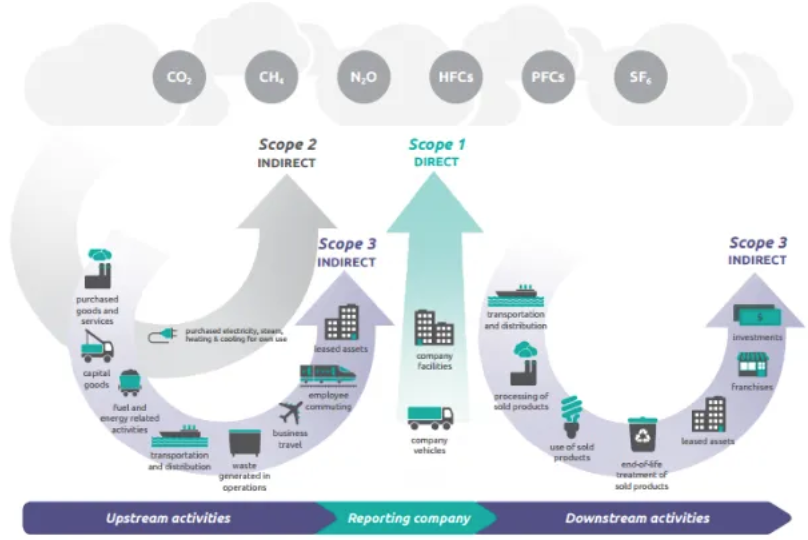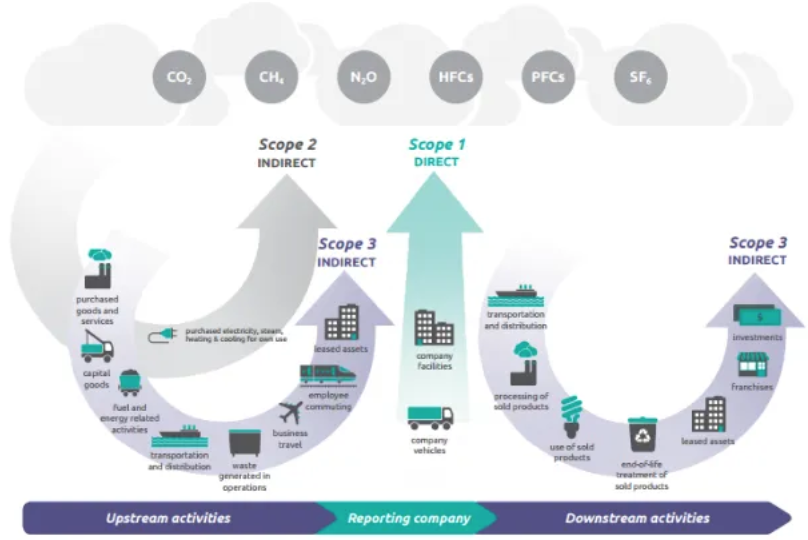Why we don’t need more Scopes to describe emissions
Despite the fact that we’ve moved closer to the target date for achieving Net Zero, the United Nations predicts that global greenhouse gas emissions will still be 10% greater in 2030 than they were in 2010.
In the fight against climate change, a lot of what we need to do is assign responsibility for emissions. To do that, the world has defined the concept of “emission scopes”.
There are 3 scopes for GHG emissions which are widely accepted, which we will define in this article. Having seen some articles talking about a new proposed scope, we analyze why we think it’s counter productive to the fight towards climate neutrality (read on to find out why).

Source: Greenhouse Gas Protocol
Let’s start with some definitions
Scope 1
Scope 1 emissions include the direct releases occurring within a company’s production process, involving assets under its ownership and control. These emissions are produced by various sources like boilers, furnaces, machinery and equipment, as well as vehicles utilizing fuel.
For buildings, Scope 1 emissions include the boiler that heats your tap water, company vehicles, and the heater that keeps your office space warm.
 How to slash Scope 1 emisssions from buildings: Improve energy efficiency, for example by better insulation, or by replacing an HVAC system as they reach their end of its life with a more energy-efficient ones.
How to slash Scope 1 emisssions from buildings: Improve energy efficiency, for example by better insulation, or by replacing an HVAC system as they reach their end of its life with a more energy-efficient ones.
Scope 2

Photo by Ahmet Kurt
These emissions are indirect GHG emissions associated with the consumption of purchased electricity, heat, or steam.
In the case of buildings, when a building relies on electricity purchased from the grid or heat/steam from an external provider, the emissions resulting from the production of that energy are considered scope 2 emissions.
Scope 3
All indirect emissions related to an entity’s supply chain are included in scope 3 emissions. They can range from the materials used in a specific product (e.g. in a building), or the methods used by third-party providers to dispose of their trash to the emissions brought on by air or rail travel for business.
Scope 3 emissions can be notoriously difficult to measure and control because they are out of the immediate control of a business’s activities.
Overcoming the challenges associated with these emissions is crucial, and data collection is a powerful way to address the problems.
 Tip: The 2050 Materials project tool will allow an estimation of the Scope 3 emissions of a building
Tip: The 2050 Materials project tool will allow an estimation of the Scope 3 emissions of a building
“Scope 4” Emissions
Scope 4 emissions, a new term created by the World Resources Institute, refers to the emission reductions that occur outside of a value chain or the life cycle of a product — which are also commonly referred to as avoided emissions.
In theory, this scope encourages organizations to employ and develop innovative carbon-saving materials and techniques.
 While it’s important to clearly define the type and source of emissions, “Scope 4” emissions are bound to be calculated (generously) by companies and used as a way to “offset” their emissions from Scopes 1, 2 and 3, creating more room for greenwashing
While it’s important to clearly define the type and source of emissions, “Scope 4” emissions are bound to be calculated (generously) by companies and used as a way to “offset” their emissions from Scopes 1, 2 and 3, creating more room for greenwashing
It is important to note that as scope 4 emissions belong to a completely distinct category than the rest of the other scope emissions, they shouldn’t be taken into account when attempting to compute for scope 1, scope 2, and scope 3 emissions.
Our concern however is that referring to averted emissions as “Scope 4” validates them and that their misuse and misunderstanding will be worse than what we currently have with Scope 3.
The climate doesn’t care about scopes
The concept of scopes is only useful to help account and assign responsibilities of emissions. As described above, new concepts of “avoided emissions” should be, well, avoided.
2050 Materials is a technology and data company providing innovative tools for climate impact evaluation in the built environment.

Start free at app.2050-materials.com
References
- LLOYD ALTER — Scoping out carbon emissions
- Radicle — Learn How To Reduce Scope 1, 2, and 3 Emissions
- Tapio — What are scopes 1, 2, and 3 of a corporate carbon report?
- Net 0 — What Are Scope 1, 2, and 3 Emissions?
- World Economic Forum — It’s time for companies to take on ‘scope 3’ emissions to tackle the the full climate impact of their products
- Greenhouse Gas Protocol -You, too, can master value chain emissions
Related articles

Climate-Resilient Materials for the Built Environment: A Data-Centred Prime
As climate volatility intensifies, resilience metrics are fast becoming as critical as carbon data in material selection. This article outlines why adaptation is now a design imperative, how materials can be evaluated through a systems lens, and what KPIs project teams should demand. From self-healing concrete to fire-rated façades, we present a structured taxonomy of resilient materials, explain how to embed this intelligence into digital design workflows, and propose next steps for specification, benchmarking, and procurement.
Read more
The Most Interesting Low Carbon Products in Office Design
In this article and collection, we highlight 11 outstanding products that contribute to a lower carbon footprint in office design.
Read more
Top Low Carbon Building Boards: Performance, Benefits, and Use Cases
The building boards highlighted in this article and collection showcase low-carbon innovation in modern construction.
Read more